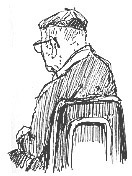| Microscopical
Society of Southern California
2005 Meeting Program
|
Weds January 19, 2005 at 7:00pm, New Roads School (map)
|
At this meeting, MSSC President, Jim Solliday, will present, "An Introduction to the Light Microscope and its History." Very few instruments have contributed to the advancement of knowledge more then the microscope. In fact the introduction of the microscope represented one of the new tools that inspired man kind into a new age of science. In this talk a historical overview will be presented illustrated by a slide show. The intention of the presentation will be to open a small window into the development of the microscope and remind the viewer what was achieved up and to the introduction of the achromatic objective. For over 400 years the microscope has both amazed and motivated men to look ever deeper into our natural world. The numerous and uncountable discoveries have both created controversy and revelation for generations of investigators. Today almost all of our understanding of how nature is built, including our own anatomy, has been revealed by the microscope. We now owe the existence of everything from the computer processor to genetically engineered medicines to the microscope. To see is to understand, and nothing has increased out ability to see more than the microscope. |
| Weds March 16, 2005 at 7:00pm, New Roads School (map)
|
Weds April 20, 2005 at 7:00pm, New Roads School (map)
|
Weds May 18, 2005 at 7:00pm, New Roads School (map)
|
At this meeting Mr. Dave Wietbrock, a very experienced microscope service
specialist, will give a talk and hands-on activity entitled, "Cleaning
Techniques for Microscopes." Mr. Weitbrock operates his own
service business, but prior to this worked for 12 years with A.G. Heinz.
Bring along one of your microscopes to work on. Mr. Wietbrock will provide
a cleaning kit with essentials for all members present. The subjects Mr.
Wietbrock will be covering will include care of all optical surfaces,
solutions and lubrications. After the break, our Education Chair, Alan
deHaas, will talk about |
| Weds July 20, 2005 at 7:00pm, New Roads School (map) At this meeting Dr. Patrick Joseph Krug will give a presentation entitled, "Sex, lies, and digitized video tape: larval development and habitat choice in sea slugs." Most animals that live in the sea produce microscopic larvae that are difficult to study due to their small size. Larvae swim in the plankton until they locate a suitable habitat on the bottom, where they settle and metamorphose into the adult form of the animal. Dr. Krug studies how such tiny organisms can accomplish this task in a place the size of the ocean. His focus is on a group of sea slugs that are highly picky eaters: each species lives and feeds on only one type of seaweed. Their larvae therefore have to find, recognize, and attach to the right kind of seaweed; chemicals from the seaweed then trigger their metamorphosis into a juvenile slug. Slugs produce their larvae through a prodigious sex life that would make many blush; he will also discuss group sex, hypodermic insemination, frustrated virgins, and other facets of reproduction that make these organisms so interesting to study. |
At this meeting the first speaker will be MSSC Education Chair, Alan deHaas. He will discuss the development of the microscope, in particular, why certain features are the way they are and how they developed. He will help us understand the reasons behind the now standard shapes and mechanical features of a microscope which have become nearly universal in use, and explain why some designs have advantages over others. After the break, MSSC President, Jim Solliday will give another of his colorful slideshows. One of the main difficulties in photomicrography is getting enough contrast; digital software can be used to enhance, isolate and change all or any part of an image. This slideshow will highlight phase contrast images - which is also the topic of the next hands-on workshop on Saturday, August 20, 2005. |
Weds September 21, 2005 at 7:00pm, New Roads School (map) Note this meeting will be in the Yang room instead of the usual Huerta room
|
Weds October 19, 2005 at 7:00pm, New Roads School (map) At this meeting our speaker will be Davin Malasarn, a Ph.D.
student from California Institute of Technology. His presentation is entitled,
"Arsenic Contamination Requires Studies on Every Scale."
In Bangladesh, one in four people is poisoned with arsenic from |
Weds November 16, 2005 at 7:00pm, New Roads School (map) This is the annual Exhibition Meeting of the Society. This is one of the best events of the year and is a great deal of fun. Each member is encouraged to bring along an exhibit to share. Anything associated with microscopic subjects is welcome. Your exhibit could be simple, for example you could set up your microscope with your favorite slide. A projector will be provided for those bringing 35mm slides. Posters and display boards are also encouraged, along with the usual sales table. Please remember to bring a label or piece of paper with a brief description of your exhibit. |
No December meeting, instead the MSSC Holiday Banquet, December, 10, 2006 at 6:00pm at the Earth Wind and Fire Restaurant, 2222 Wilshire Blvd, Santa Monica CA 90403. The program theme will be the Origin and Development of the Light Microscope and MSSC member, Stuart Walter, will give a brief presentation after dinner. Cost $20 per person. Contact Herb Gold to make reservations. |
WHAT'S
NEW? / MSSC HOME PAGE / MSSC
HISTORY / PROGRAM SCHEDULE /
ITEMS FOR SALE / NEWS
AND EVENTS / ARTICLES & RESOURCES / CONTACT US / HOW TO JOIN / LINKS / MEMBERS
AREA


Cartoons by Nirvan Mullick
Site created and maintained by Leonie
Fedel
Please email comments
© MSSC